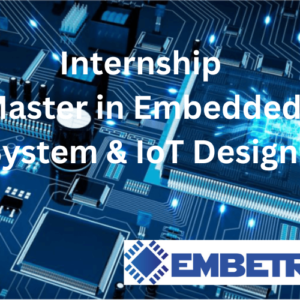- Introduction to Embedded C
- What is Embedded System & Need for Embedded System
- What is a Program?
- Programming languages in Embedded Systems
- Types of Processors and Controllers in Embedded System
- Difference between Microprocessor and Controller
- Difference between DSP Processor and Microcontroller
- Difference betweeen CPLD and FPGA
- Need for DSP in FPGA
- FPGA VS ASIC)
- What is SOC
- Comparision of Processor
- Embedded Development Lifecycle
- What is IDE ,List of IDE
- Understanding Microcontroller Programming
- What is Microcontroller and Block diagram of various Microcontroller
- What is an IDE
- IDE & Compiler Installation
- Creating a Project for Host
- Address Variables and Storage Classes
- How to Write functions
- Understanding Microcontroller programming
- Build Process and Analyzing Embedded C Code
- Floating Point data and Scanf
- Pointers and stdint.h
- Operators
- Decision Taking Statements
- Loops
- Structures
- Typedef with Structure
- Arrays
- Type Qualifier
- Strings
- Blinking LED
- Bitwise Operators
- STM32 Cube IDE
- Structures and Bit field
- Structure and Union
- Keypad Interfacing
- UART Programming in C -Part1
- UART Programming in C (Building from Scratch) -Part2
- UART Programming in C (Using ST Headerfile)
- LCD Interface using STM32F411
- I2C Interface with ADXL345 -Part1
- I2C Interface with ADXL345 -Part2
- SPI Interface with ADXL345
- Project: Design an Application in C for the MCQ examination
- Top 200 Interview Questions
Every session / topic would be followed by programming tips viz:
- Common Programming Errors: Students learning a language – especially in their first programming course – tend to make certain kinds of errors frequently. Focusing on these Common Programming Errors helps students avoid making the same errors.
- Good Programming Practices: Good Programming Practices are tips for writing clear programs. These techniques help student produce programs that are more readable, self-documenting and easier to maintain.
- Performance Tips: In our experience, teaching students to write clear and understandable programs is the most important goal for a first programming course. But students want to write the programs that run the fastest, use of least memory, require smallest number of keystrokes,. Students really care about performance. They want to know what they can do to “turbo charge” their programs. So we highlight opportunities for improving program performance-making programs run faster or minimizing the amount of memory that they occupy.
- Portability Tips: Software development is a complex and expensive activity. Organizations that develop software must often produce versions customized to a variety of computers and operating systems. So there is a strong emphasis today on portability, i.e., on producing software that will run on a variety of computer systems with few, if any, changes. Achieving portability requires careful and cautious design. There are many pitfalls.
- Software Engineering Observations: The Software Engineering Observations highlight techniques, architectural issues and design issues, etc. that affect the architecture and construction of software systems, especially large-scale systems.
- Self-Review Exercises and Answers: This gives the student a chance to build confidence with the material and prepare to attempt the regular exercises.





Reviews
There are no reviews yet.